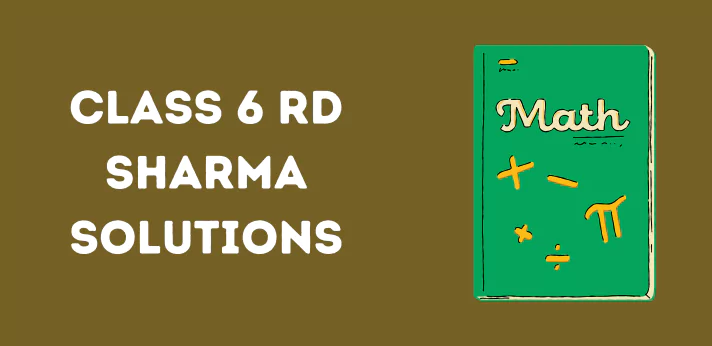Prepare effectively for your final exams and achieve high scores with Class 6 RD Sharma Solutions available here. Edufever presents the finest solution manual, RD Sharma Solution for Class 6 to 12, which stands out as the premier resource on the internet. The solutions are meticulously arranged chapter-wise and further segmented according to exercises, facilitating effortless navigation for students to pinpoint and access solutions for specific topics. With RD Sharma Class 6 Solutions, students can grasp mathematical concepts more efficiently and enhance their understanding.
Discover the most suitable solution books for CBSE Class 6 RD Sharma mentioned in this article. Access the CBSE 6 RD Sharma Book Solution in PDF Format to elevate your preparation to the next level.
[Index]
Overview
Before we discuss the Class 6 RD Sharma Solution, let us check the CBSE Class 6 Summary; below, we have mentioned the complete CBSE Class 6 Summary. Students are advised to check out the complete summary.
| Particulars | Description |
| Class | 6th |
| Board | CBSE |
| Category | RD Sharma Solution |
| Study Materials | Click Here |
| Class 6 Free E-Book | Click Here |
| YouTube Channel | Subscribe now |
CBSE Class 6 RD Sharma Solutions in PDF
Below we have mentioned the RD Sharma Solution for Class 6. Students have checked the complete Class 6 RD Sharma Book Solution in PDF for a great score in the final examination.
CBSE Class 6 Maths Syllabus 2024-25
Understanding the Maths, Mathematical questions, and other mathematical operations is a concern for Class 6 Mathematics. Let us now discuss the CBSE Class 6 Maths syllabus with topics covered and the month assigned.
| Chapter Name | Topic to be Covered |
| Chapter 1: Knowing Our Numbers | 1.1 Introduction 1.2 Comparing Numbers 1.3 Large Numbers in Practice 1.4 Using Brackets 1.5 Roman Numerals |
| Chapter 2: Whole Numbers | 2.1 Introduction 2.2 Whole Numbers 2.3 The Number Line 2.4 Properties Of Whole Numbers 2.5 Patterns in Whole Numbers |
| Chapter 3: Playing With Numbers | 3.1 Introduction 3.2 Factors and Multiples 3.3 Prime and Composite Numbers 3.4 Test For Divisibility Of Numbers 3.5 Common Factors and Common Multiples 3.6 Some More Divisibility Rules 3.7 Prime Factorisation 3.8 Highest Common Factor 3.9 Lowest Common Multiple 3.10 Some Problems on HCF and LCM |
| Chapter 4: Basic Geometrical Ideas | 4.1 Introduction 4.2 Points 4.3 A Line Segment 4.4 A-line 4.5 Intersecting Lines 4.6 Parallel Lines 4.7 Ray 4.8 Curves 4.9 Polygons 4.10 Angles 4.11 Triangles 4.12 Quadrilaterals 4.13 Circles |
| Chapter 5: Understanding Elementary Shapes | 5.1 Introduction 5.2 Measuring Line Segments 5.3 Angles-’Right’ and ‘Straight’ 5.4 Angles- ‘Acute’, ‘Obtuse’ and ‘Reflex’ 5.5 Measuring Angles 5.6 Perpendicular Lines 5.7 Classification of Triangles 5.8 Quadrilaterals 5.9 Polygons 5.10 Three Dimensional Shapes |
| Chapter 6: Integers | 6.1 Introduction 6.2 Integers 6.3 Addition of Integers 6.4 Subtraction of Integers with the help of a Number Line |
| Chapter 7: Fractions | 7.1 Introduction 7.2 A Fraction 7.3 Fraction on the Number Line 7.4 Proper Fractions 7.5 Improper and Mixed Fractions 7.6 Equivalent Fractions 7.7 Simplest Form of a Fraction 7.8 Like Fractions 7.9 Comparing Fractions 7.10 Addition and Subtraction of Fractions |
| Chapter 8: Decimals | 8.1 Introduction 8.2 Tenths 8.3 Hundredths 8.4 Comparing Decimals 8.5 Using Decimals 8.6 Addition of Numbers with Decimals 8.7 Subtraction of Decimals |
| Chapter 9: Data Handling | 9.1 Introduction 9.2 Recording Data 9.3 Organisation of Data 9.4 Pictograph 9.5 Interpretation of a Pictograph 9.6 Drawing a Pictograph 9.7 A Bar Graph |
| Chapter 10: Mensuration | 10.1 Introduction 10.2 Perimeter 10.3 Area |
| Chapter 11: Algebra | 11.1 Introduction 11.2 Matchstick Patterns 11.3 The Idea Of A Variable 11.4 More Matchstick Patterns 11.5 More Examples of Variables 11.6 Use Of Variables in Common Rules 11.7 Expressions with Variables 11.8 Using Expressions Practically 11.9 What is an Equation? 11.10 Solution of an Equation |
| Chapter 12: Ratio and Proportion | 12.1 Introduction 12.2 Ratio 12.3 Proportion 12.4 Unitary Method |
| Chapter 13: Symmetry | 13.1 Introduction 13.2 Making Symmetric Figures: Ink-blot Devils 13.3 Figures With Two Lines of Symmetry 13.4 Figures with Multiple Lines of Symmetry 13.5 Reflection and Symmetry |
| Chapter 14: Practical Geometry | 14.1 Introduction 14.2 The Circle 14.3 A Line Segment 14.4 Perpendiculars 14.5 Angles |
Class 6 Study Material
We have tried to bring CBSE Class 6 NCERT Study Materials like Syllabus, Worksheet, Sample Paper, NCERT Solutions, Important Books, Holiday Homework, Previous Year Question Papers etc. You can visit all these important topics by clicking the links given.
